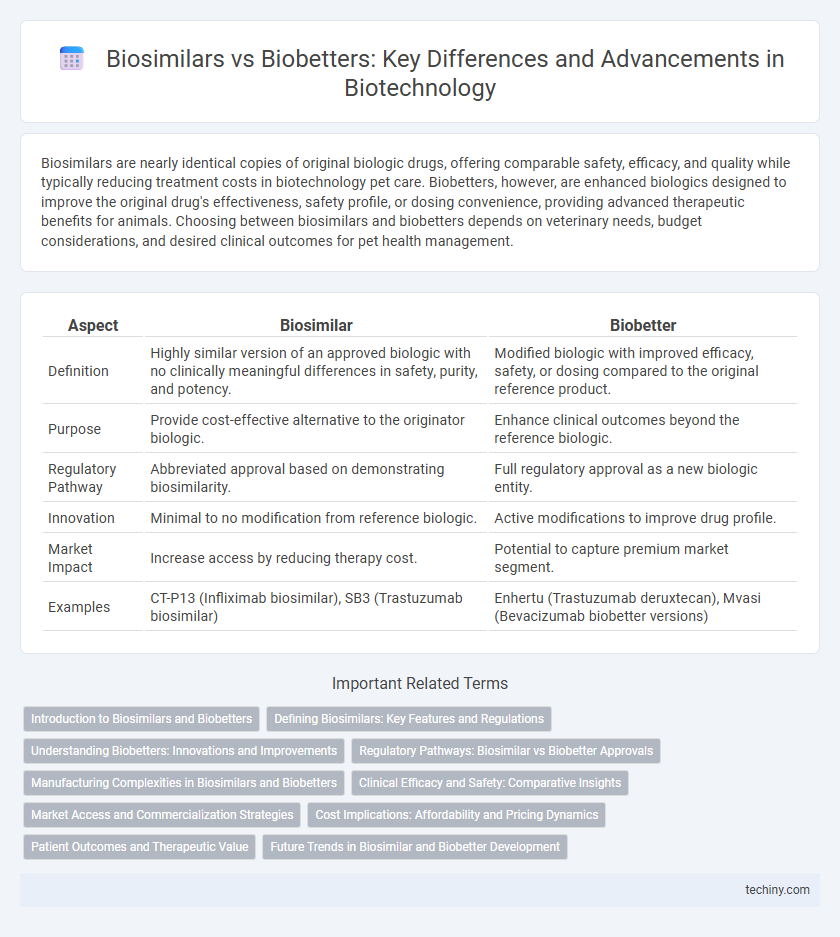Biosimilars are nearly identical copies of original biologic drugs, offering comparable safety, efficacy, and quality while typically reducing treatment costs in biotechnology pet care. Biobetters, however, are enhanced biologics designed to improve the original drug's effectiveness, safety profile, or dosing convenience, providing advanced therapeutic benefits for animals. Choosing between biosimilars and biobetters depends on veterinary needs, budget considerations, and desired clinical outcomes for pet health management.
Table of Comparison
| Aspect | Biosimilar | Biobetter |
|---|---|---|
| Definition | Highly similar version of an approved biologic with no clinically meaningful differences in safety, purity, and potency. | Modified biologic with improved efficacy, safety, or dosing compared to the original reference product. |
| Purpose | Provide cost-effective alternative to the originator biologic. | Enhance clinical outcomes beyond the reference biologic. |
| Regulatory Pathway | Abbreviated approval based on demonstrating biosimilarity. | Full regulatory approval as a new biologic entity. |
| Innovation | Minimal to no modification from reference biologic. | Active modifications to improve drug profile. |
| Market Impact | Increase access by reducing therapy cost. | Potential to capture premium market segment. |
| Examples | CT-P13 (Infliximab biosimilar), SB3 (Trastuzumab biosimilar) | Enhertu (Trastuzumab deruxtecan), Mvasi (Bevacizumab biobetter versions) |
Introduction to Biosimilars and Biobetters
Biosimilars are biologic medical products highly similar to an already FDA-approved original reference product, with no clinically meaningful differences in safety, purity, or potency. Biobetters, also known as biosuperiors, are enhanced versions of existing biologics designed to improve efficacy, reduce side effects, or extend half-life. The development of biosimilars focuses on demonstrating equivalence, while biobetters involve innovation to provide superior therapeutic benefits.
Defining Biosimilars: Key Features and Regulations
Biosimilars are biologic medical products highly similar to an already approved reference biologic, maintaining no clinically meaningful differences in safety, purity, and potency as outlined by regulatory agencies like the FDA and EMA. Key features include rigorous analytical characterization, comparative clinical trials, and adherence to stringent manufacturing controls to ensure consistency and interchangeability with the reference product. Regulations mandate robust pharmacovigilance and post-marketing surveillance to monitor long-term safety and efficacy, facilitating biosimilar market entry while maintaining therapeutic equivalence.
Understanding Biobetters: Innovations and Improvements
Biobetters represent the next generation of biologic drugs, engineered to enhance efficacy, safety, and patient compliance compared to original biologics. Innovations in biobetters include improved pharmacokinetics, reduced immunogenicity, and optimized delivery methods, offering significant therapeutic advantages over biosimilars. These enhancements position biobetters as valuable alternatives in personalized medicine and advanced treatment strategies within the biotechnology industry.
Regulatory Pathways: Biosimilar vs Biobetter Approvals
Biosimilars undergo regulatory pathways requiring comprehensive demonstration of similarity to an already-approved reference biologic, focusing on analytical, preclinical, and clinical comparability to ensure safety and efficacy. Biobetters, designed to improve on the original biologic with enhanced efficacy, safety, or dosing, face a distinct approval process involving full clinical development and demonstration of superior clinical benefits. Regulatory agencies like the FDA and EMA have established clear guidelines distinguishing biosimilar abbreviated pathways from biobetter pathways, which demand more extensive innovation and data.
Manufacturing Complexities in Biosimilars and Biobetters
Biosimilars face significant manufacturing complexities due to the strict requirement to closely replicate the reference biologic's molecular structure and function, necessitating highly controlled cell culture and purification processes. Biobetters involve additional modifications to improve efficacy or safety, introducing further challenges in optimizing expression systems and ensuring consistent post-translational modifications. Both processes demand advanced analytical techniques and robust quality control to maintain product comparability and therapeutic performance.
Clinical Efficacy and Safety: Comparative Insights
Biosimilars demonstrate comparable clinical efficacy and safety to their reference biologics by matching pharmacokinetic and pharmacodynamic profiles within rigorous regulatory frameworks. Biobetters, engineered for enhanced therapeutic outcomes, often show improved efficacy or safety profiles through molecular modifications that optimize target interactions or reduce immunogenicity. Comparative clinical trials emphasize biosimilars' equivalence while highlighting biobetters' potential advantages in treatment durability, dosing frequency, and adverse event reduction.
Market Access and Commercialization Strategies
Biosimilars benefit from established regulatory pathways and lower development costs, enabling faster market access and competitive pricing strategies that increase adoption in cost-sensitive healthcare markets. Biobetters offer enhanced efficacy or safety profiles, allowing premium pricing and differentiated market positioning, which require targeted commercialization efforts and robust payer engagement. Strategic collaborations with healthcare providers and payers are critical for both biosimilars and biobetters to optimize market penetration and reimbursement outcomes.
Cost Implications: Affordability and Pricing Dynamics
Biosimilars offer significantly reduced costs compared to original biologics due to abbreviated clinical trials and streamlined regulatory pathways, enhancing affordability and market competition. Biobetters, while often priced higher than biosimilars, provide improved efficacy or safety profiles which can justify premium pricing and potentially lower long-term healthcare expenses. The pricing dynamics reflect a balance between accessibility for patients through biosimilars and incremental therapeutic benefits offered by biobetters that influence payer decisions and reimbursement strategies.
Patient Outcomes and Therapeutic Value
Biosimilars offer comparable patient outcomes to original biologics by providing equivalent safety and efficacy profiles, enhancing accessibility through reduced costs. Biobetters, engineered to improve therapeutic value, exhibit enhanced efficacy, longer half-life, or reduced immunogenicity, leading to better clinical outcomes and patient adherence. The choice between biosimilars and biobetters impacts personalized treatment strategies, optimizing disease management in biotechnology-driven healthcare.
Future Trends in Biosimilar and Biobetter Development
Future trends in biosimilar and biobetter development emphasize enhanced biosafety profiles, improved therapeutic efficacy, and cost-effective production methods leveraging advanced bioprocessing technologies. Innovations in protein engineering and glyco-modification are driving the creation of biobetters with superior pharmacokinetics and reduced immunogenicity. Regulatory harmonization and the adoption of artificial intelligence in drug design accelerate the development pipelines, fostering personalized medicine and expanded market access.
Biosimilar vs Biobetter Infographic

 techiny.com
techiny.com